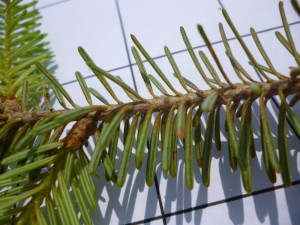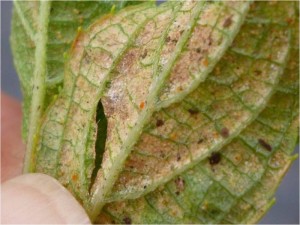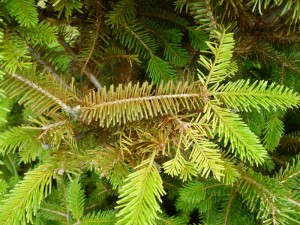In the New Jersey region, the late weeks of September & early weeks of October are transition periods for warm season & cool season spider mite species found in landscapes & nurseries. The spruce spider mite & the southern red spider mite are the most common cool season species & they are now “waking-up” from their summer inactive period. Alternatively, the warm season two-spotted spider mite may have stopped feeding or will soon cease. They are rapidly declining & preparing to depart the leaves of their host plants if they have not already done so.

Two-spotted spider mites that produced these stippling symptoms on burning bush this summer are now entering dormancy with the arrival of autumn
(Photo: Steven K. Rettke of RCE)

Spruce spider mites that were previously in a summer dormancy are now resuming activity again on this Frasier-fir as the autumn season arrives (Salem County Nursery) (Photo: Steven K. Rettke of RCE)
Two-spotted spider mites (Tetranychus urticae) are warm season mites that are most active between the months of June through September. They are commonly seen feeding on burning bush, rose, forsythia, & many perennial plants. In some areas the two-spotted spider mite populations may still be active in early October. If they are still active, then closely observe with a hand-lens the infested leaf undersides for the appearance of mites with a reddish-orange coloration. This change in color is a sign indicating adult females are preparing to enter the overwintering dormant stage.

Up-close view of reddish-orange two-spotted spider mite adult females as they prepare for winter dormancy
(Photo: Kristen Hall)

Two-spotted spider mites change to a reddish-orange coloration as the adult females prepare for winter dormancy (Photo: Steven K. Rettke)
As the night temperatures cool during the early autumn weeks, the two-spotted spider mite slows activity, stops laying eggs & begins to go into dormancy. Adult females overwinter beneath the host plant in the soil/mulch. In these concealed areas, the overwintering mites will be out of reach from any miticide applications (including dormant oil sprays). By October, any further plant damage caused by two-spotted spider mites will be slight. Therefore, control treatments applied now will have limited value. Many of the overwintering females may have already dropped off the plant. Also, the reddish-orange adult females still on leaf undersides have essentially stopped feeding & spray treatments of miticides will have reduced efficacy.

Avoid the potential of confusing the similar colors of the two-spotted spider mite dormancy preparation with the Phtyoseiulus persimilis predatory mite species as shown above (Photo: Denise Crawford)
On the other hand, with the arrival of autumn & cooler temperatures, both spruce & southern red spider mites begin to “wake-up” from their summer dormancy & can be observed feeding & laying eggs. Spruce spider mites (Oligonychus ununguis) will feed exclusively on various conifers, whereas southern red spider mites (Oligonychus ilicis) will feed on various broadleaf evergreens.
Feeding damage to the foliage from these cool season mite species occur during the spring & fall months. Some landscape & nursery managers may not realize significant damage to conifers & broadleaf evergreens can occur during the fall. Monitor now for the resumption of mite activity on previously injured host plants by using a beating tray & 16X hand-lens.
The photographs below show older spider mite symptoms on a Frasier fir & a Pieris japonica (Japanese Andromeda). Observe the feeding damage on both previously infested plants. The leaf stippling symptoms on the older, inner growth is apparent on both plants. These cool season mites fed on the older 2012 growth of the respective hosts during last fall & spring. When the newer, outer growth emerged during this past season, the mites did not have the opportunity to do much feeding damage before they became dormant in late spring. For example, when June temperatures reach highs of 85° F. & above, then this signals the spruce spider mites to begin to move into the summer dormant stage. Furthermore, the new needles of conifers often contain toxins that deter spider mite feeding. The toxins dissipate after the needle tissues mature.

A photograph taken this past summer at a Cumberland County Christmas tree farm showing spring feeding damage to Frasier-fir by spruce spider mites. The newer, outer growth of 2013 will be infested this fall. (Photo: Steven K. Rettke of RCE)

Southern red spider mites produced spring stippling symptoms to the lower, inner leaves on this Andromeda. The new growth from this season has partially covered the damaged leaves. This fall the mites will infest the newer, upper foliage. (Photo: Steven K. Rettke of RCE)
The emerging southern red & spruce spider mites can potentially continue to feed until the late weeks of fall. In fact, some of the most damaging symptoms can occur from late October through November. Overwintering eggs are laid in late fall when freezing temperatures begin to occur. The eggs of spruce spider mites will be found primarily near the base of needles on woody twigs. Conversely, the eggs of southern red spider mites will be on the undersides of broadleaf leaves. These red colored eggs are easily observed beneath the foliage. Both mite species can produce a few generations during the fall season.

Building southern red spider mites & eggs observed this fall on Azalea at a Cumberland County nursery
(Photo: Steven K. Rettke of RCE)

Southern red spider mite infestation on Azalea observed with already very active mites, eggs, & cast skins at Cumberland County nursery (Photo: Steven K. Rettke)

